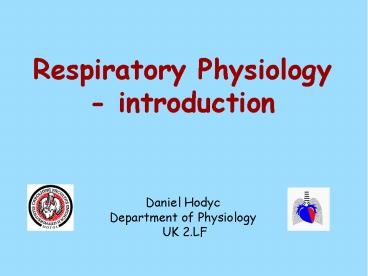Respiratory Physiology - introduction - PowerPoint PPT Presentation
Title:
Respiratory Physiology - introduction
Description:
Respiratory Physiology - introduction Daniel Hodyc Department of Physiology UK 2.LF 1. Pulmonary Ventilation 2. Mechanics of Breathing 3. Ventilation/perfusion ratio ... – PowerPoint PPT presentation
Number of Views:422
Avg rating:3.0/5.0
Title: Respiratory Physiology - introduction
1
Respiratory Physiology- introduction
Daniel Hodyc Department of Physiology UK 2.LF
2
1. Pulmonary Ventilation2. Mechanics of
Breathing3. Ventilation/perfusion ratio,
regulation4. Regulation of Breathing
Respiratory Physiology
3
1. Pulmonary ventilation - transport of gases
to alveoli2. Pulmonary diffusion factors
determining gas transport across the
membrane3. Perfusion 4. Ventilation/perfusion
ratio
Gas transport in lungs
4
1. Partial pressure2. Lung volumes and
capacities3. Alveolar ventilation4.
Anatomical and functional death space,
effective ventilation
Pulmonary ventilation
5
Partial pressure of the gas
- in determined by its concentration in the
mixture and by the overall pressure of the gas
mixture PatmO2 Patm FO2 PatmO2 740 torr
0,21 - in the liquid - partial pressure of the
gas component, which is balanced with the liquid
6
Lung volumes and capacities
7
Lung volumes and capacities
Spirometer - measurement of lung volumes
- measurement of the oxygen consumption
8
Measurement of residual volume and FRC - helium
equilibration method
C1 V1
C2 (V1 V2)
9
Measurement of functional residual capacity -
pletysmograph
Boyls law P V const P1 V1 P1 (V1 -
dV) P2 V2 P2 (V2 dV) V2 FRC
P1 V1
P2 V2
10
Air composition in respiratory system
11
Alveolar ventilation
ventilation of anatomic dead space
02
C02
inspiration
expiration
12
Alveolar ventilation
13
Relationship between tidal volume, frequency and
effective ventilation
Minute ventilation ml/min Tidal volume ml Frekvency c/s Alveolar Ventilation ml/min Ventilation Anat. dead space ml/min Effective ventilation
8000 250 32 3200 4800 40
8000 500 16 5600 2400 70
8000 1000 8 6800 1200 85
Why not to breathe with minimal frequency?
Work of breathing
14
Measurement of anatomic dead space
Fowlers method
- insp - 100 02 - exp - nitrogen
concentration measurement
VD
15
Physiologic dead space ventilated but not
perfused alveoli
VD
PaCO2
PECO2
-
Bohr equation
PaCO2
VT
VT
ventilation of anatomic dead space
VA
ventilation of physiologic dead space
VAeff
PECO2
PACO2
PaCO2
16
Uneven ventilation
The worst ventilation - apical parts
17
- lung volumes measurable by spirometer
(VT,IRV,ERV) - RV, FRC - measurable by He,
plethysmograph- anatomic dead space-
effective ventilation and respiratory frequency,
work of breathing- physiologic dead space,
Summary
18
Thank you for your attention
Pictures and schemes J.B.West - Respiratory
Physiology, LWW - Guyton,
Hall - Textbook of Medical Physiology, 11th































